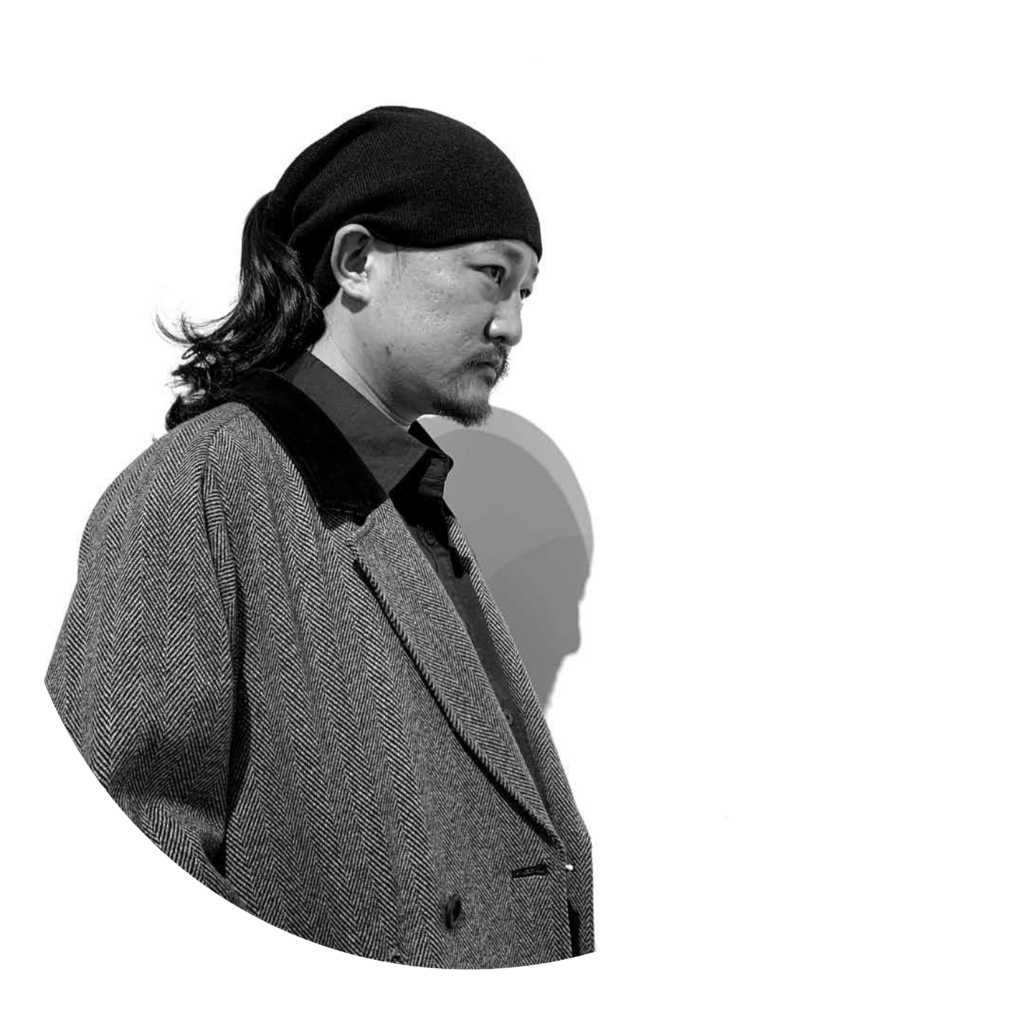
蓝庆伟 Lan Qqingwei
批评家,策展人,成都大学教师 Critic, Curator, teacher at Chengdu University
文/蓝庆伟 2017.09
王彦鑫:我在场
“我带点儿倔,有点冷,这也许和我来自西北有关,骨子里有狼性。”这是王彦鑫自述中的一句话,也几乎是所有认识他的人的印象写照。第一次见到王彦鑫是在四川美术学院新媒体系的一次展览现场,一位正在扇自己耳光的年轻人吸引了许多目光——他一边扇自己的耳光,一边问自己面前的人“你叫什么名字?”,被问者倔强不语,全然不管做作品的人每问完一遍就更加用力的扇自己耳光,连观众都忍不住说“你就说嘛”,但被问者无论如何都不说,场面愈发尴尬,也令人无法忘记。后来问起才知这位自扇耳光的年轻人是个艺术家,叫王彦鑫,当天他实施创作的这件作品就叫《你的姓名》。与胡佳艺、童文敏一样,他也是四川美术学院新媒体系最初的几届学生,不同的是王彦鑫是这批优秀学院“成果”中少有的男性,新媒体系曾用“十朵金花”为名给女学生们做展览,但却没有“十大金刚”之类的男生展,性别比例由此可见一斑。
王彦鑫2017年前的作品看起来有点笨,是典型的行为艺术创作方法中的身体性创作,强调作品中的痛感,尤其是以自己身体的不可控来换取观众的心灵痛感。此类作品通常是在与观众的互动中完成的,有时候会像英雄般引导观众的思维,让观众难以分别真实与戏谑,并逐步让观众将戏谑作为真实,加之对身体的介入,使得观众主动或被迫加入到现场的思考中,来探讨观众与观众、创作者与观众、现场与内心之间的矛盾点与细微差异,让观者对现场的定义有着新的认知。惯性思维常常会把观者导向王彦鑫的自虐,但创作与生活并非全然吻合,王彦鑫对此的态度也极为明确:“用行为艺术创作的过程中我很开心,每天都可以学习到新的东西,有新的灵感,对生活很积极。”细心观众或对王彦鑫诸多作品有所了解的观众会发现,王彦鑫在创作中除了身体性之外常常伴随着一些词汇的语言呐喊,如power、hero、history is good for you、war、magic等,在王彦鑫看来,这些是“因厌恶谎言而产生的对于历史以及谎言的思考,喜欢观察身边事物,通过感受到一些周遭的处境并与自己所处地域的历史联系思考。”
“身体需要叛变,让身体颤栗,重新思考可控和不可控下的身体。让身体介入公共空间与现实与自然发生关系,重新构架身体与空间的关系。让身体通过互动与观众发生关系,重新感知人与人之间的细微变化,书写自己的身体语言与创作脉络。”王彦鑫在自述中对身体有着自己明确的见解,2016年开始,王彦鑫的作品产生了一些列的变化,创作了《白塔》、《白》、《灞柳风雪》、《重影》、《红墙》、《乌云》、《阻挡一小时》、《红毯》、《锈刀》、《消亡的轨迹》、《黑夜想起黎明》、《信仰》、《蓝图》、《历史的书写》等一系列在公共空间中的作品,这些作品构织了新的脉络,这些变化主要围绕着以下几个特征展开,首先是语言的放弃,作品中的声音不再是人为的制造,而是自然而然;其次是空间的变化,从白盒子或建筑空间走向公共空间与自然空间,完成了艺术家构建自我向解放自我的过渡;第三是从身体的使用向身体的利用的转换,身体置于环境中,所表达的是作为问题提示存在的身体。同时王彦鑫也在不断丰富个体身体介入空间的方式,视觉诗化的身体、社会景观的身体、作为隐去的身体。
王彦鑫从身体出发,不断探讨身体和身体与他者的关系,在这不断探讨的过程中也不断加入现实关怀与人文关怀,对身体语言的探索和现场的定义有独特的个人理解,并由此力求向观众呈现个人独有的艺术语言。王彦鑫执著,相信时间积累在艺术创作中的作用,正如他的自我勉励“喜欢就去做,不停的做,一意孤行,才能另辟蹊径。”
2017年9月18日星期一 成都黄土坎
Wang Yanxin: I’M PERESENT
“I come off somewhat standoffish, a bit cold. Maybe because I’m from the Northwest, my bones have a bit of wolf in them.” These are words Wang Yanxin uses to describe himself, and it just might really be how people perceive him. The first time I met Wang Yanxin was during a live art work at an exhibition in Sichuan Fine Arts Institute. He was slapping himself on the face while asking people in front him, “What’s your name?” Those he asked refused to answer, completely unaware that each time after asking, the artist would add force and slap himself even harder. The audience couldn’t bear it, and others would say “Just tell him.” But no matter what, no one would talk to him, and the scene grew increasingly awkward, making the artwork more than memorable. Upon asking, I learned that this artist was named Wang Yanxin, and that the artwork was titled Your Name. Much like Hu Jiayi and Tong Wenmin, he is amongst the first students in Sichuan Fine Arts Institute’s New Media department. What’s different about him is that Wang Yanxin is one of the only male students. The department titled a women’s’ exhibition Ten Golden Flowers, but never held a more masculine Ten Big Diamonds exhibition for male students. From this we get a sense of the female/male ratio in the department.
Wang Yanxin’s artworks prior to 2017 seem a bit basic. They are classical performance artworks, using the body as their main component, emphasizing pain and pushing the body beyond its limits in a way that especially touches viewing audiences. These types of artworks rely on a high degree of interactivity with audiences, sometimes seeming to foreground a type of heroism in leading the audience to think in certain ways, making it hard for the audience to distinguish between the real and theatrical, sometimes even leading people to mistake the absurd for the real. Then add the body’s intervention, and audiences’ willing or coerced involvement in order to explore audience-audience and artwork-audience relationships. There was also a focus upon sites of contradiction and minute differences between performance environment and artist’s inner experience of the artwork. This helped the audience to form new definitions regarding artist, artwork and performance site. Wang Yanxin finds habituated thinking abhorrent. However art and life are not as close as we think. Wang Yanxin is very clear about this, saying that, “I’m very happy in the process of creating performance artworks. I learn something new each and every single day. There’s a lot of inspiration and I feel really engaged with life.” Attentive audience members or audiences familiar with many of Wang Yanxin’s artworks may discover that accompanying his physical presence in each artwork, there is a lexicon being sprinkled throughout his corpus; words such as ‘power’, ‘hero’,’ history is good for you’, ‘war’, ‘magic’ and so on. As he explains, “Because I can’t stand some of the absurdities endemic to history, sometimes I like to just look at things around me in the midst of performing, and I feel these historical forces bearing down upon me, and I this is how I vocalize these connections.”
“The body has to revolt, it starts to shake, and I’m forced to rethink that which I can and can’t control about my body. To place the body in a public space, let it develop a relationship with nature and reality, to remap relationships formed by the body in space. To have the body interact with the public, re-apprehend the subtle changes between people, and to write the body’s language and creative train of thought.” In his description of his work, we see that Wang Yanxin has clear understanding of his body. Starting in 2016, his artworks saw a series of transformations, as he did White Tower, White, Baliufengxue, Double-image, Red Wall, Black Cloud, Obstruct One Hour, Red Carpet, Rusty Knife, Disappearing Orbit, Thinking of Dawn in the Dead of Night, Belief, Blueprint, and Writing History. These are all public works which take on a new rubric for the artist, involving the following new components. Firstly the artist lets go of spoken language; the sounds produced in the artwork are only naturally occurring non-human sounds. Next there are spatial changes, for example moving from a boxed-in space to a public or natural space, reflecting the artist’s progress towards a more natural bearing. Third, the body is more taken advantage of in its use, placing the body in an environment in ways which point out human existential predicaments. At the same time, Wang Yanxin is also constantly enriching the way he places his body in space; the visually poetic body; the social spectacle body, the hidden body.
Wang Yanxin starts with the body, ceaselessly examining its relationship both to itself as well as others. As he continues along this path, he develops more of a realist and humanities concern, bearing a unique understanding of definitions of site and linguistic exploration. Wang Yanxin persists, believing that over time his accumulated artistic exploration will be of great use. He encourages himself by saying, “If I want to, I just do it, and keep doing it, stubbornly sticking my one’s guns. Only in this way can I strike upon my own path.”
September 18, 2017, Huangtukan, Chengdu, China
// 最近新作Recent Post
// 分类Categories

1988年生于甘肃兰州,2013年毕业于四川美术学院新媒体系,现工作生活于成都,任教四川文化艺术学院,副教授。
Wang Yanxin, born in 1988 in Lanzhou, Gansu, China. graduated from Sichuan Fine Arts Institute in 2013. Since 2012, he has been engaged in multimedia artistic creation based on performance art. He currently lives and works in Chengdu and is a professor at Sichuan Conservatory of Culture and Arts.
- Chengdu, Sichuan, China
- +86 15215015022
订阅Newsletter
Copyright by wangyanxin.com. 版权所有.

-1.png)
